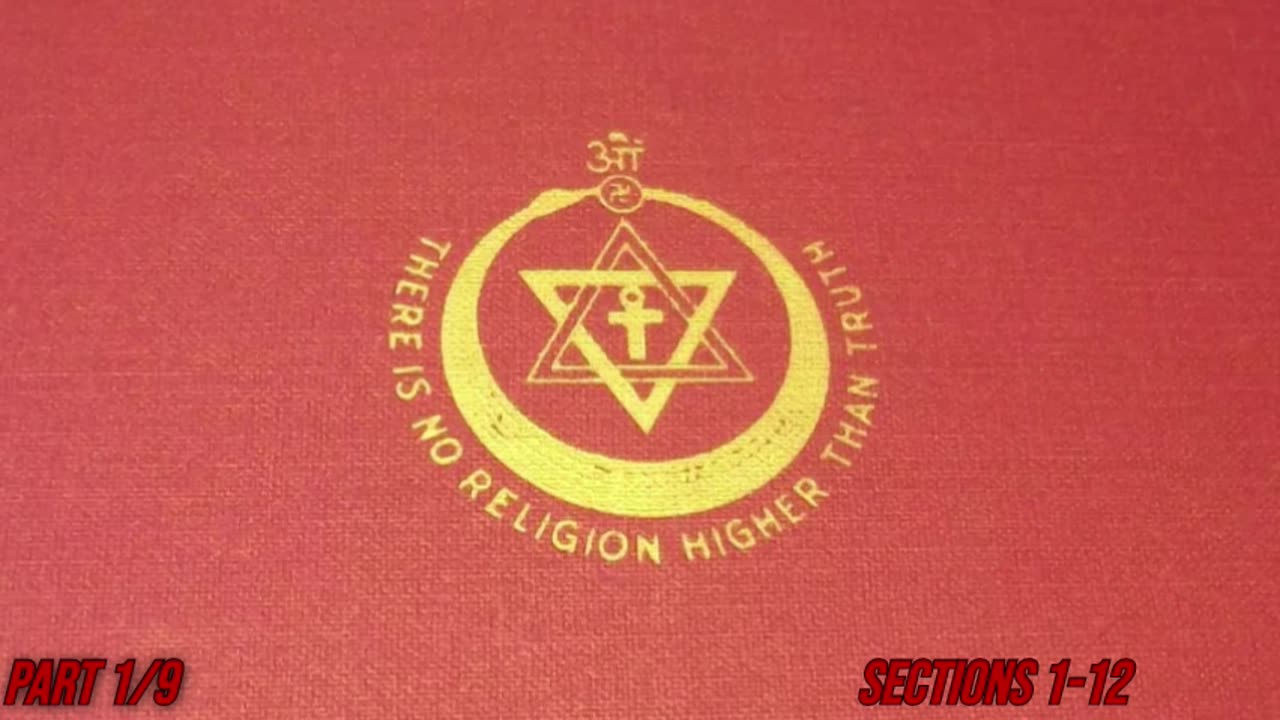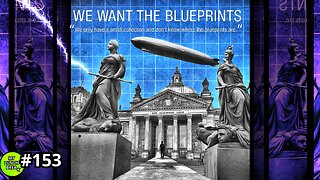Premium Only Content

The Secret Doctrine by Blavatsky Part 1/9 Sections 1-12
Part 1 (Sections 1-12) of "The Secret Doctrine" by Helena Petrovna Blavatsky serves as an introduction to the core themes of her monumental work. This part lays the foundation for the cosmological and metaphysical teachings that Blavatsky elaborates on throughout the text. It introduces the reader to the esoteric philosophy that Blavatsky claims is based on ancient wisdom from a variety of spiritual traditions, including Hinduism, Buddhism, Kabbalah, Gnostic Christianity, and Hermeticism. This initial section is highly complex, involving a blend of mythology, theosophy, and occult teachings.
Overview of Part 1:
The first part of "The Secret Doctrine" is largely focused on the cosmogony or the origin of the universe according to ancient wisdom. Blavatsky argues that all religious systems have a common source of truth, which she calls the Ancient Wisdom Religion or Esoteric Tradition. Her aim is to demonstrate that these truths have been passed down through sacred texts and mystical traditions across time, though often hidden or misunderstood.
Key Concepts and Sections in Part 1:
1. The Proem:
The Proem serves as an introduction to the entire work, offering an overview of the metaphysical concepts that will be explored. Here, Blavatsky lays out the Three Fundamental Propositions of the Secret Doctrine:
1st Proposition: The existence of an omnipresent, eternal, boundless, and immutable principle that underlies all existence. This is often equated with concepts like Parabrahman in Hinduism or the Absolute in Western esotericism.
2nd Proposition: The principle of periodicity, which refers to the cyclical nature of the universe, including the creation, destruction, and recreation of worlds. This concept is central to her vision of cosmic evolution.
3rd Proposition: The belief in the fundamental unity of all souls and the idea that consciousness is universal, with individual consciousness being an expression of this greater whole.
2. Cosmic Evolution:
Blavatsky introduces the Stanzas of Dzyan, an ancient Tibetan text that she claims to have translated. These stanzas describe the formation of the universe, beginning with a primordial void and the emergence of cosmic principles that shape reality. Each stanza is followed by Blavatsky's commentary, where she attempts to decode the symbolic language of the stanzas.
In these sections, Blavatsky outlines the seven stages or rounds of universal evolution, where each round represents a cycle in which spiritual and material elements interact to bring about manifestation.
3. The Role of the Logos and Divine Mind:
Blavatsky describes the Logos, or divine creative force, which acts as a mediator between the Absolute and the manifested universe. This concept is akin to Brahma in Hindu cosmology or the Word in Christian mysticism.
She discusses the role of cosmic intelligence, or the Universal Mind, which brings order to chaotic matter. This intelligence is said to operate through spiritual hierarchies or Dhyani-Chohans (spiritual beings or deities), who assist in the formation of the cosmos.
4. Symbolism and Mythology:
Blavatsky frequently draws parallels between the Stanzas of Dzyan and myths from various cultures, such as Hindu, Egyptian, Greek, and Gnostic traditions. She claims that these myths are allegorical descriptions of cosmic events and spiritual truths.
The symbolism in this section is dense, filled with references to serpents, dragons, lotuses, and sacred geometrical forms, which she believes represent deeper universal principles.
5. The Law of Correspondences:
A recurring theme in Part 1 is the Law of Correspondences, which asserts that as above, so below—the microcosm reflects the macrocosm. Blavatsky applies this idea to everything from the structure of atoms to the evolution of galaxies, suggesting that the same principles govern all levels of existence.
This idea is fundamental to understanding Blavatsky’s belief that esoteric teachings can reveal the hidden laws of nature and spirit.
Purpose of Part 1:
This part serves as the cosmic blueprint of Blavatsky's theosophical worldview. It sets the stage for the detailed discussions of anthropogenesis (the evolution of humanity) and occult science that follow in later sections.
By emphasizing the commonalities among world religions and mythologies, Blavatsky aims to validate the universal nature of the Ancient Wisdom Religion, which she believes has been partially preserved in the esoteric doctrines of the world’s great traditions.
Style and Presentation:
Blavatsky’s writing in Part 1 is dense and complex, characterized by arcane references and symbolic interpretations. She often assumes a background knowledge of esoteric concepts, making the work challenging for those unfamiliar with occult terminology.
The structure of Part 1 alternates between commentary on the Stanzas of Dzyan and philosophical expositions, creating a blend of mystical poetry and metaphysical discourse.
Significance of Part 1:
Part 1 is crucial for understanding Blavatsky’s cosmology and serves as the foundation for the philosophical framework that guides the rest of "The Secret Doctrine." It is a complex introduction to her vision of the universe as an interconnected and cyclical reality governed by hidden spiritual laws.
It also represents Blavatsky's attempt to bridge ancient wisdom with modern science, positioning her teachings as a continuation of hidden knowledge that has been preserved across mystical traditions.
ABOUT THE AUTHOR:
Helena Petrovna Blavatsky (1831-1891)
Helena Petrovna Blavatsky—often known simply as Madame Blavatsky or HPB—was a Russian occultist, mystic, and co-founder of the Theosophical Society, a movement that sought to reconcile spirituality with science and philosophy by drawing upon ancient esoteric traditions. Born on August 12, 1831, in Ekaterinoslav, then part of the Russian Empire (now Dnipro, Ukraine), she is widely considered one of the most influential figures in the modern esoteric and occult revival of the late 19th century. Her writings and teachings, particularly "Isis Unveiled" (1877) and "The Secret Doctrine" (1888), continue to shape New Age thought, Western esotericism, and spiritual movements to this day.
Early Life and Influences
Blavatsky was born into a noble Russian family, with her mother, Helena Andreyevna von Hahn, being a novelist and her father, Colonel Peter Hahn, serving in the Russian military. From a young age, she displayed an interest in the mystical and supernatural, with accounts of her life mentioning experiences with clairvoyance, telepathy, and astral travel. Her family's access to Western literature and philosophy exposed her to esoteric ideas early on, which she later developed into her own theosophical framework.
In her early adulthood, Blavatsky embarked on extensive travels that took her across Europe, the Middle East, India, and Tibet. During these journeys, she claimed to have studied with esoteric teachers and initiates, particularly in India and Tibet, who taught her the ancient wisdom traditions that would form the core of her later teachings.
Founding of the Theosophical Society
In 1875, Blavatsky co-founded the Theosophical Society in New York City with Henry Steel Olcott and William Quan Judge. The society aimed to:
1. Promote the study of comparative religion, philosophy, and science.
2. Investigate unexplained laws of nature and the powers latent in humanity.
3. Promote universal brotherhood, transcending distinctions of race, creed, sex, caste, or color.
The Theosophical Society played a pivotal role in introducing Eastern philosophies, such as Hinduism and Buddhism, to the Western world, promoting the idea that all religions contain an underlying spiritual truth. Blavatsky served as the spiritual head of the movement, positioning herself as a messenger for the hidden masters or Mahatmas, whom she claimed were enlightened beings guiding the spiritual evolution of humanity.
Key Works and Esoteric Teachings
"Isis Unveiled" (1877): Blavatsky’s first major work sought to challenge materialism and scientific reductionism, arguing that ancient wisdom held the keys to understanding spiritual phenomena and the hidden aspects of nature. The book covered a wide range of subjects, from mythology to comparative religion, psychic phenomena, and occult sciences.
"The Secret Doctrine" (1888): This two-volume work is considered her magnum opus. It lays out a cosmological vision based on the Stanzas of Dzyan, which she claimed were ancient texts from Tibet. The first volume, "Cosmogenesis", focuses on the origin of the universe and cosmic evolution, while the second volume, "Anthropogenesis", explores the esoteric history of humanity through the seven root races. Blavatsky aimed to provide a synthesis of science, religion, and philosophy, drawing upon Eastern mysticism, Hermeticism, and Kabbalistic traditions.
Affiliations with Secret Societies
Blavatsky’s life and work were deeply intertwined with the esoteric traditions and secret societies that she studied and promoted. While there is some ambiguity surrounding her precise affiliations, her connections to various mystical and occult orders are well-documented:
1. Freemasonry:
Blavatsky claimed connections with Freemasonry, particularly through Co-Freemasonry and esoteric branches of the craft that included women, which was unusual for traditional Freemasonry. She was associated with Rite of Adoption lodges, a branch of Continental Masonry that allowed female members.
Her writings often reflect a Masonic worldview, utilizing symbolism and concepts familiar to Masonic teachings, such as the spiritual significance of geometric shapes and initiatory practices.
2. Rosicrucianism:
Blavatsky’s teachings frequently align with Rosicrucian ideals, emphasizing the existence of a hidden knowledge that dates back to ancient Egypt, Hermeticism, and alchemical traditions. She often spoke of the Rosicrucians as being among the guardians of ancient wisdom.
While no direct records confirm her initiation into a formal Rosicrucian order, Blavatsky’s writings suggest a deep sympathy for Rosicrucian principles, particularly in her emphasis on spiritual alchemy and the transmutation of the soul.
3. Hermetic Brotherhood of Luxor:
Blavatsky’s early writings and teachings have connections to the Hermetic Brotherhood of Luxor, a 19th-century occult order that combined Egyptian mysteries with Western esotericism. Some sources suggest that she had correspondences with members of this brotherhood, sharing a common interest in ancient Egyptian mysticism.
The Hermetic principles she discusses in her writings, such as the Law of Correspondence ("As above, so below"), reflect the influence of Hermetic thought on her theosophical worldview.
4. Kabbalistic Traditions:
Blavatsky’s work is heavily influenced by Jewish Kabbalah, which she viewed as a repository of esoteric wisdom with roots in ancient Chaldean and Egyptian mysticism. She believed that Kabbalistic teachings were closely related to the mysteries of the East, drawing parallels between Kabbalistic concepts and Vedic philosophy.
Although not formally initiated into any Kabbalistic society, Blavatsky incorporated Kabbalistic symbols, such as the Sephiroth and the Tree of Life, into her interpretation of the cosmos and spiritual evolution.
Controversies and Criticisms
Blavatsky’s life and work were marked by significant controversy. She faced criticism and skepticism from the scientific community of her time, as well as from Christian missionaries who opposed her promotion of Eastern religions in the West. Her claims of communication with the Mahatmas were challenged by skeptics, most notably during the Hodgson Report published by the Society for Psychical Research in 1885, which accused her of being a charlatan. However, many of her followers continued to believe in her spiritual authority and the validity of her occult experiences.
Legacy and Impact
Blavatsky’s influence extends far beyond her lifetime, shaping the New Age movement, Western occult traditions, and esoteric schools of thought. Her emphasis on the unity of all religions, the divine nature of the cosmos, and the importance of spiritual evolution has had a profound impact on mystical traditions and philosophical inquiries into the nature of reality. The Theosophical Society she co-founded continues to have branches around the world, promoting the study of esoteric philosophy and spiritual science.
Helena Petrovna Blavatsky remains a polarizing figure—revered by many as a spiritual visionary and pioneer of esoteric thought, while criticized by others as a controversial mystic with unorthodox ideas. Regardless of perspective, her role in reshaping the Western spiritual landscape and bridging Eastern and Western philosophies is undeniable, making her a central figure in the history of modern esotericism.
-
 18:12:15
18:12:15
Deus Meum Que Jus
1 day agoWilliam Cooper - HOTT - Best of - Open Phones 2 (Various Dates)
1.1K -
 12:38
12:38
Timcast
20 hours agoJasmine Crocket HUMILIATED By CNN To HER FACE Over Epstein LIE | Tim Pool
31.7K47 -
 19:32
19:32
MetatronHistory
17 hours agoWas Nazism Left Wing or Right Wing? An Answer From History
4403 -
 LIVE
LIVE
a12cat34dog
1 hour agoI'M FINALLY BACK :: Resident Evil 4 (2023) :: FINISHING MAIN GAME & DLC {18+}
217 watching -
 DVR
DVR
Stephen Gardner
59 minutes agoFINALLY! Charlie Kirk MISSING DETAILS released!
2.76K9 -
 LIVE
LIVE
cosmicvandenim
5 hours agoCOSMIC VAN DENIM | SEX APPEAL & HORROR
73 watching -
 LIVE
LIVE
DoldrumDan
1 hour agoFINISHING SEKIRO - DEPTH 5 TOP RANKED - DAY 50 NEW LIFE
18 watching -
 23:40
23:40
MYLUNCHBREAK CHANNEL PAGE
1 day agoWe Want the Blueprints
45.5K13 -
 LIVE
LIVE
PenguinSteve
2 hours agoLIVE! Penguin to the Battlefield (6)
37 watching -
 1:08:20
1:08:20
The Quartering
3 hours agoMTG Quits, Indian X Meltdown & FBI Caught Lying Again About Trump Assassin
123K67